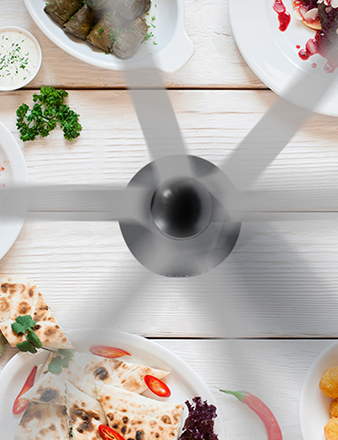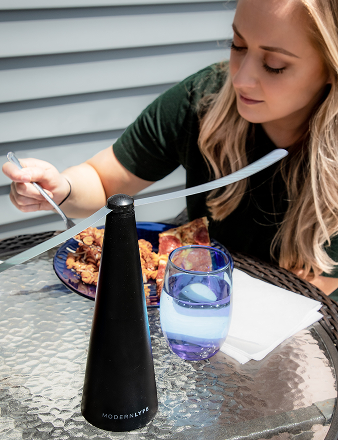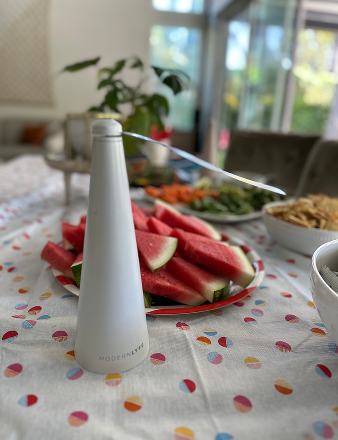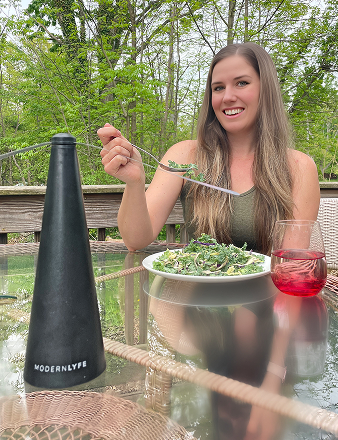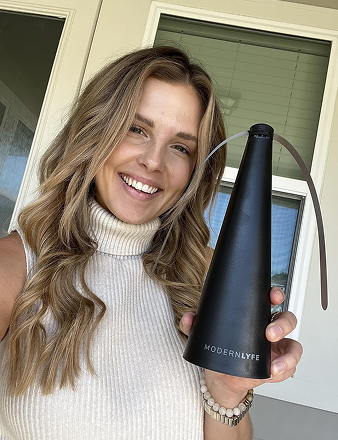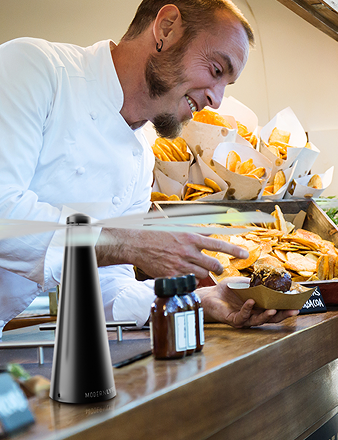The best fly repellent for a restaurant isn't a single product—it's a smart system combining proactive prevention with effective, food-safe control. A lone fly can make customers doubt your cleanliness, so an integrated strategy is the only way to protect your reputation. This means sealing entry points, maintaining spotless sanitation, and using modern tools like fly fans.
Protecting Your Restaurant From Unwanted Guests

It only takes one fly to ruin a five-star meal. This small problem creates a massive perception issue, instantly making guests question your kitchen's hygiene. In the restaurant business, reputation is everything, and a pest sighting can quickly become a negative online review that deters future customers.
Flies are more than a nuisance; they are a direct threat to your brand, food safety, and bottom line. Fly control isn’t just another task on a cleaning list—it's a fundamental investment in your business.
The True Cost of a Fly Problem
That fly buzzing around the dining room is a genuine health hazard. Flies carry over 100 different pathogens, including harmful bacteria like Salmonella and E. coli. Every time a fly lands on a plate, countertop, or a customer's food, it can spread those germs and create a real risk of foodborne illness.
This risk extends far beyond one customer's bad experience. Keeping pests under control is critical for several reasons:
- Customer Trust: A clean, pest-free space shows guests you take their health seriously.
- Brand Reputation: Online reviews are powerful. A reputation for being unclean is nearly impossible to fix.
- Regulatory Compliance: Keeping your restaurant fly-free is a key part of passing any restaurant health inspection checklist.
Shift from Reaction to Prevention
Waiting until you see flies to act is a losing strategy. The best restaurants build a defense system designed to stop flies from ever getting inside. This means sealing entry points, maintaining rigorous sanitation, and using an effective fly repellent in dining areas. A proactive approach is non-negotiable for maintaining high standards.
The most effective pest management strategies are built on prevention. By denying entry and eliminating attractants, you solve the problem at its source instead of constantly fighting the symptoms.
Adopting this mindset protects every meal you serve and guarantees every guest enjoys the clean, safe, and welcoming atmosphere you’ve worked hard to create.
Know Your Enemy: Common Restaurant Flies
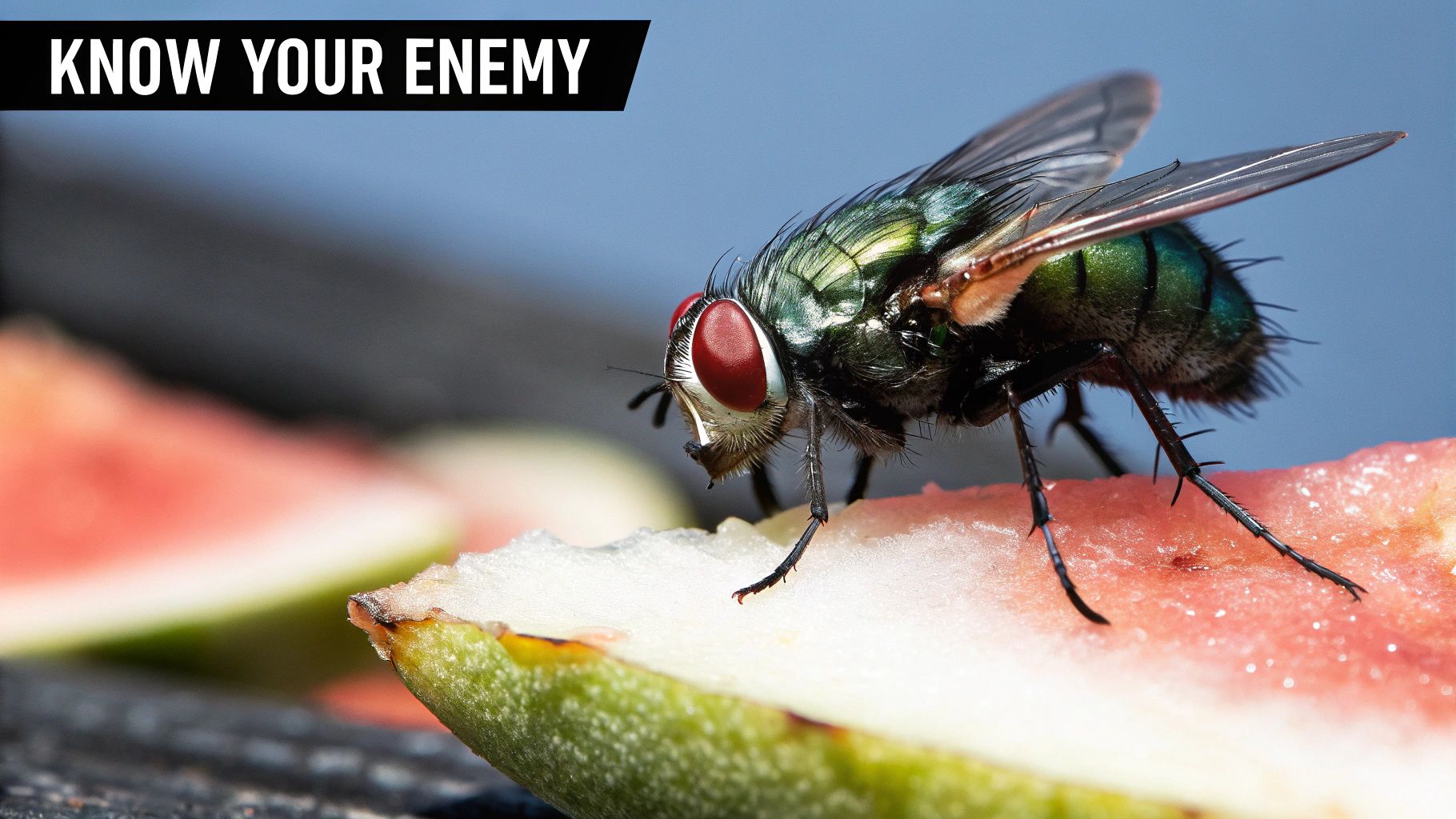
To win the war against flies, you need to know what you're fighting. Just as a chef understands their ingredients, a smart restaurant owner must understand the pests trying to invade their space. Not all flies are the same, and knowing their habits is the key to keeping them out.
Most restaurants deal with two main offenders: the common house fly and the pesky fruit fly. Each has unique behaviors, attractions, and breeding grounds, which means your defense plan must be specific.
Meet Your Unwanted Guests
The house fly (Musca domestica) is the one you probably picture first. It's larger, louder, and drawn to almost any organic waste, from the dumpster out back to a crumb on a plate. These are classic "filth flies," breeding in rotting material, which makes your garbage area a prime target.
Then there's the fruit fly (Drosophila melanogaster). These are the tiny gnats that appear in swarms, seemingly from nowhere. They are experts at detecting fermenting sugars, making them fans of:
- Overripe fruit and vegetables on prep counters
- Sticky spills from soda or cocktails at the bar
- Residue at the bottom of recycling bins
- Moisture and buildup inside drains
Identifying the type of fly helps you locate the source of the problem. A house fly might signal an issue with your dumpster management, while a cloud of fruit flies points to a hidden spill or a drain that needs cleaning.
The Lifecycle of an Infestation
Here’s where it gets serious. A single female house fly can lay up to 500 eggs in her short life. In a warm restaurant, those eggs can hatch in under 24 hours and become flying adults in as little as a week.
This explosive reproductive cycle means one or two flies can become a full-blown infestation almost overnight. The problem isn't the fly you see—it's the hundreds more that could be developing out of sight.
A smart fly repellent strategy isn't about swatting what's in the air; it's about breaking the breeding cycle on the ground. Cut off their food and breeding sites to stop the problem before it starts.
This is a huge deal in the food service industry. As consumer awareness of food safety grows, the demand for effective restaurant pest control is increasing. Although flies account for 95% of pest sightings in restaurants, a shocking 75% of these incidents go unreported. Customers don't complain; they just leave and never return.
Knowing your enemy is the first step to victory. By understanding the types of flies and how they operate, you can make your prevention efforts count, keeping your restaurant clean, safe, and welcoming for paying customers.
A Modern Approach to Integrated Pest Management
The old-school approach to flies was simple: see a fly, grab a chemical spray. This reactive method is unsafe for food environments and ultimately ineffective.
Today, the gold standard is a smarter, more comprehensive system called Integrated Pest Management (IPM).
Think of IPM as a strategic playbook for fly control. It’s a philosophy that prioritizes proactive prevention over reactive spraying. Instead of constantly fighting the flies you see, IPM focuses on creating an environment where flies can't establish themselves in the first place.
The Three Pillars of IPM
A solid IPM strategy relies on three core principles that work together to create a powerful defense. Each pillar addresses a different aspect of the fly problem, from entry points to attractants. This multi-layered defense is the secret to long-term success.
These aren't just suggestions; they are the foundation of any effective fly repellent for restaurant strategy.
- Exclusion: Your first line of defense is physically blocking flies from entering. This includes sealing cracks around windows, installing tight-fitting door sweeps, and using air curtains at busy entrances. Simple, but effective.
- Sanitation: This pillar focuses on removing what attracts flies. Meticulous cleanliness is non-negotiable. It means wiping up spills immediately, keeping garbage cans tightly covered, and regularly cleaning drains to remove buildup.
- Source Reduction: This is where you eliminate their breeding grounds. Source reduction involves finding and removing materials where flies lay eggs—like damp corners, uncovered trash bins, and any rotting organic waste near dumpsters.
This proactive framework is widely recognized as a superior alternative to relying on traditional insecticides. IPM strategies have become standard for restaurants because they prioritize non-chemical methods, aligning with public demand for safer pest control. You can learn more about IPM's effectiveness through available research.
Why IPM Outperforms Chemical Sprays
Relying solely on chemical sprays is like trying to bail out a sinking boat with a teacup instead of plugging the hole. It addresses the symptom, not the root cause. A chemical-heavy approach also introduces risks to your food, staff, and guests, and over time, flies can develop resistance.
IPM offers a much safer and more sustainable solution.
By focusing on why flies are drawn to your restaurant, IPM empowers you to solve the problem at its core. It’s a smarter, more permanent fix that protects both your reputation and your bottom line.
This chart illustrates how effective each pillar of IPM is in stopping fly infestations.
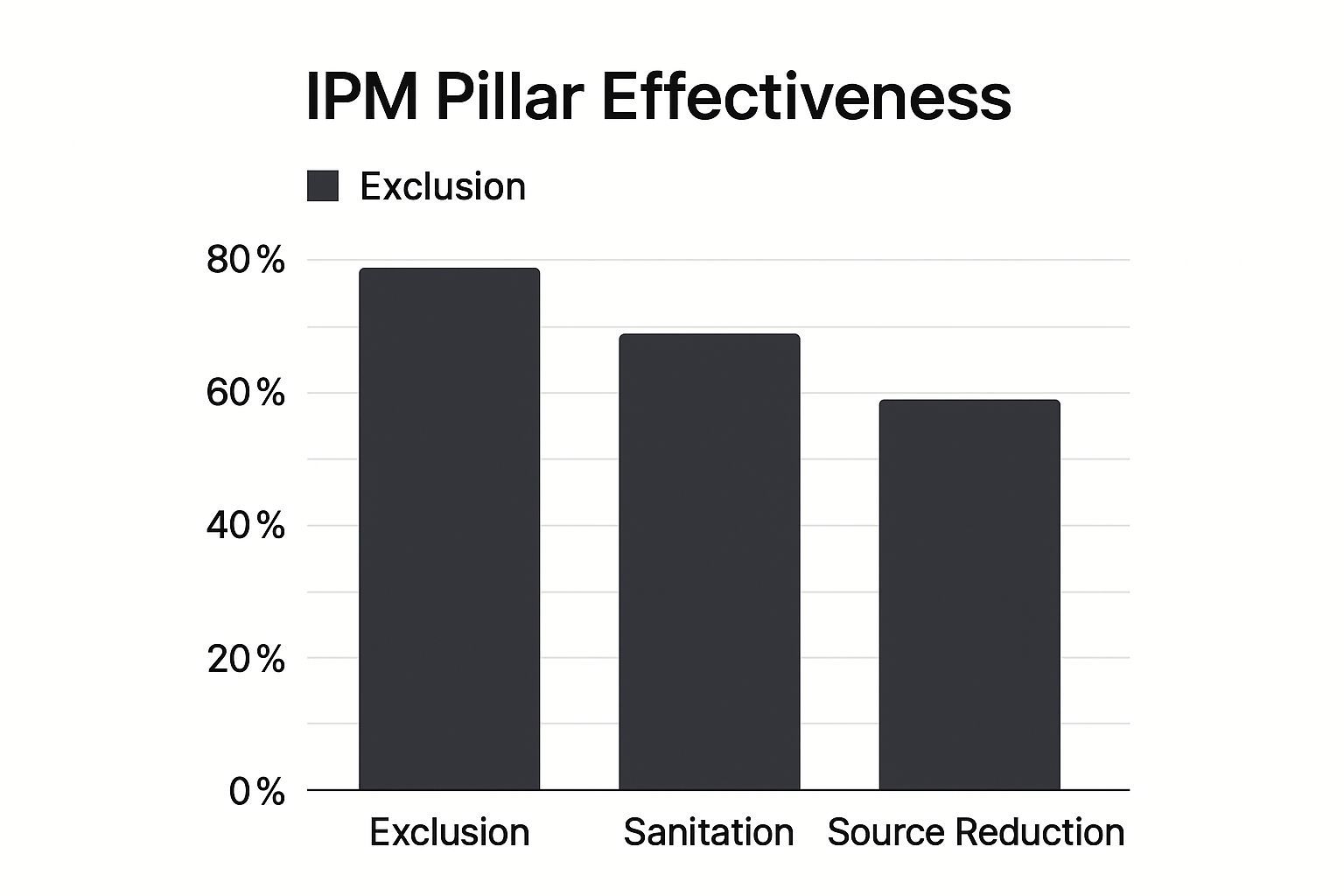
As the data shows, physically excluding pests is the most impactful step you can take. However, a truly comprehensive defense requires all three pillars working together for maximum effect.
For a deeper dive into building your own defensive plan, check out our guide on fly control for restaurants.
Ultimately, adopting an IPM mindset means shifting from a constant battle to creating an environment that is naturally pest-free. This modern approach is more effective and demonstrates a commitment to the safety and quality today’s diners expect.
Comparing Fly Repellent Systems
Once you've sealed every entry point and perfected your sanitation, it’s time for active measures. Choosing the best fly repellent for your restaurant means evaluating your options and matching them to different areas of your space.
What works in a busy kitchen isn't the right fit for your dining room or patio. Here’s a breakdown of the most common systems—their strengths and weaknesses—so you can build a layered defense that works for each specific zone.
Back of House: Power and Safety
In the kitchen and storage areas, effectiveness and food safety are paramount. This is where the heavy-hitters come in.
UV Light Traps
Walk into most professional kitchens, and you’ll see a UV light trap, or insect light trap (ILT). They're a staple for a reason.
These devices use ultraviolet light to attract flies. Once close, the flies are captured on a sticky glue board inside. A crucial note: avoid old-school "zapper" models. For any food prep area, glue board traps are the only safe option. Zappers can cause an "insect explosion," sending tiny fragments into the air—a major food safety hazard.
- The Good: They work 24/7, are silent, chemical-free, and highly effective in enclosed spaces like kitchens.
- The Not-So-Good: Their industrial look makes them unsuitable for customer areas. You must also change the glue boards regularly to maintain effectiveness.
Guarding Entrances: Air Curtains
Think of an air curtain as an invisible bouncer for your restaurant. Mounted above high-traffic doorways, these units push a powerful, continuous stream of air downward.
This invisible wall of air is too strong for flies to penetrate. It's a brilliant, non-chemical way to protect your entire establishment every time a door opens.
An air curtain creates an impassable barrier for flying insects. It's a proactive defense that stops flies before they even get inside, keeping your restaurant a fly-free zone.
They are a game-changer for restaurants with patios or any entrance that is constantly opening and closing.
Front of House: Discretion is Key
In dining areas, the goal is different. You need solutions that work without announcing a pest problem. It's all about effective, discreet control.
Discreet Sticky Traps and Modern Fly Fans
Modern Sticky Traps: Forget ugly, dangling flypaper. Today’s sticky traps are far more sophisticated, available in designs that look like decorative wall sconces or small units that can be tucked away discreetly. They use visual cues or pheromones to attract any stray flies.
- Effectiveness: Great for catching the occasional straggler.
- Aesthetics: Choose models designed for front-of-house use to maintain your ambiance.
- Placement: Position them out of direct sightlines but near potential fly hotspots like windows or server stations.
The Rise of the Fly Fan: For protecting individual tables, buffet lines, and outdoor patios, modern fly fans are an elegant and powerful tool. They work on a simple principle: the gentle but constant breeze disrupts a fly's delicate wings and navigation.
This air movement creates a protective bubble around food and guests. Flies find the area too turbulent to land and simply move on. No chemicals, no smells, no noise—just peace of mind.
To make the choice clearer, let's compare these options.
Comparing Fly Repellent Options for Restaurants
Every tool has its place. This chart breaks down where each one excels in a restaurant setting.
| Repellent Type | Effectiveness | Food Safety Risk | Aesthetic Impact | Best For |
|---|---|---|---|---|
| UV Light Traps | High (in enclosed areas) | Low (with glue boards) | Low (industrial look) | Kitchens, storage areas |
| Air Curtains | Very High (at entrances) | None | Neutral (functional) | Main entrances, receiving doors |
| Discreet Sticky Traps | Moderate (for low volume) | None | Moderate (can be hidden) | Dining rooms, host stands |
| Fly Fans | High (for specific zones) | None | High (can be stylish) | Patios, dining tables, buffets |
Ultimately, a fly-free restaurant isn't about finding one magic bullet. It’s about strategically combining these systems to create a comprehensive defense tailored to every unique space within your establishment.
Why Fly Fans Are a Restaurant Game Changer
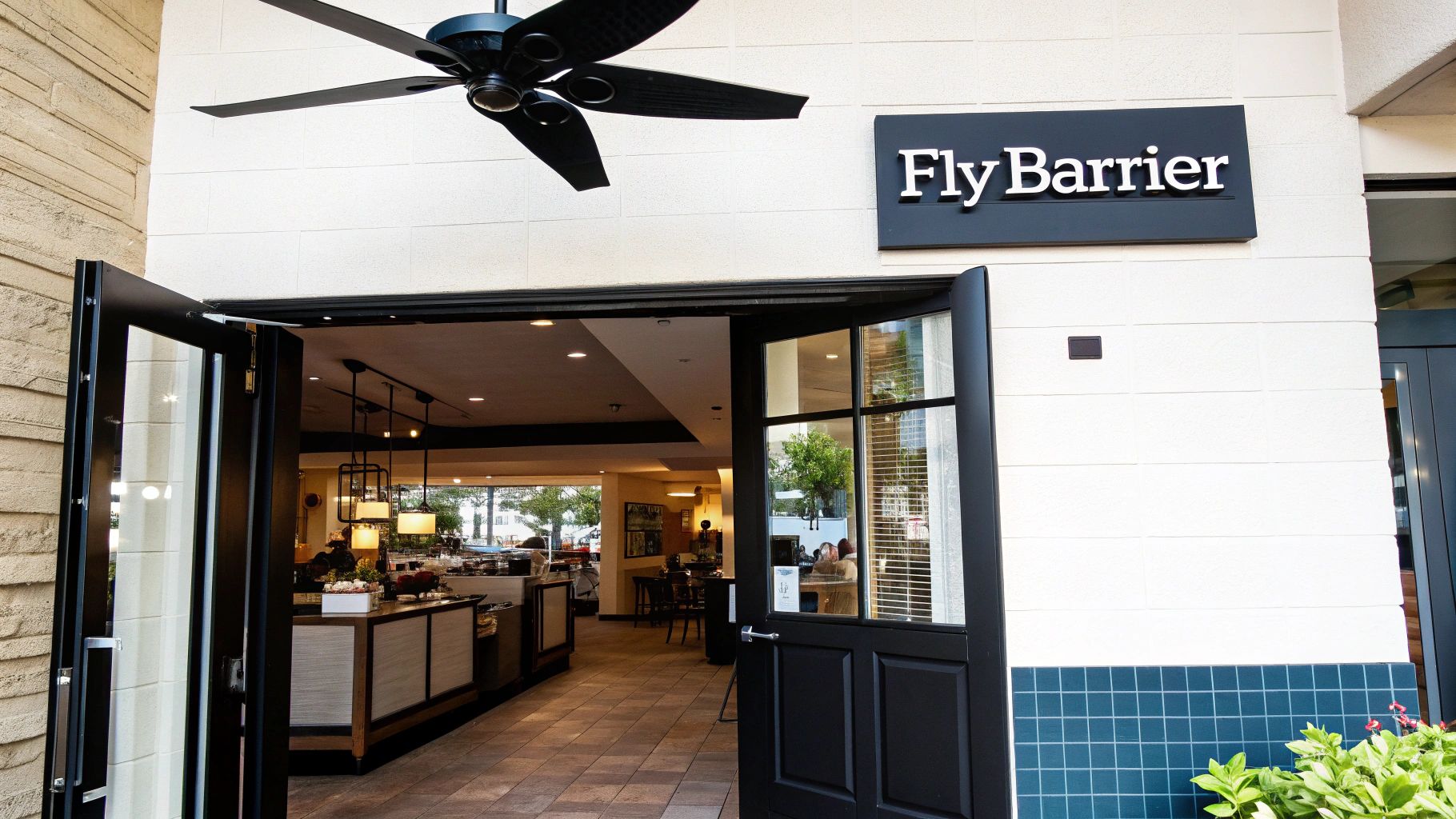
Sometimes the simplest ideas are the most effective. Fly fans offer elegant, targeted protection right where your guests are sitting. They have become a game changer for patios, service areas, and dining rooms where ambiance is as important as cleanliness.
The technology is simple. The fan's blades create gentle, consistent air currents that make it nearly impossible for a fly to navigate or land.
For a small insect, the subtle breeze is like trying to land a helicopter in a windstorm. It's too turbulent and unpredictable. This creates an invisible, chemical-free barrier around tables and food, turning the area into a no-fly zone. The flies aren't harmed; they're simply deterred, ensuring a pleasant dining experience. This makes a fly fan an essential fly repellent for restaurant owners who value both performance and atmosphere.
The Clear Benefits of Fly Fans
Fly fans offer a unique set of advantages that other systems can't match. They are designed to enhance the dining environment, not detract from it.
Here’s why they are a popular choice:
- Completely Chemical-Free: This is their biggest selling point. Fly fans provide total peace of mind with no sprays, toxins, or chemicals near your customers' food.
- Silent Operation: Forget the loud zap of bug zappers. Modern fly fans are engineered to be whisper-quiet, so they won't interrupt conversations or disrupt the atmosphere.
- Energy Efficiency: Most high-quality fans run on batteries and are designed for low power consumption, making them a cost-effective solution for all-day use.
- Aesthetic Enhancement: Far from being an eyesore, today’s fly fans feature sleek, modern designs that can complement your decor.
This combination of features makes them perfectly suited for protecting the most valuable and vulnerable parts of your restaurant.
Perfect Placement for Maximum Impact
Fly fans excel where other repellents are impractical. Because they're portable and targeted, they're perfect for dynamic spaces like patios and buffet stations. While an air curtain protects your main entrance, a fly fan protects the individual meal.
Use them in these key areas:
- Outdoor Patios and Al Fresco Dining: This is where fly fans dominate. They create a comfortable, pest-free bubble around each table, letting guests enjoy the outdoors without swatting at flies.
- Buffet Lines and Catering Stations: A few fly fans along a buffet keep the entire spread protected, ensuring food stays hygienic and appealing.
- Host Stands and Service Bars: A fan at these points stops flies from gathering where guests and staff constantly interact.
- Open-Air Entryways: For cafes or bistros with open-front designs, fly fans provide an extra layer of defense right where pests might enter.
By creating a localized zone of protection, fly fans allow you to deliver a premium, pest-free experience precisely where it matters most—right in front of your customer. This level of targeted control is something broader systems cannot offer.
This makes them an invaluable part of a layered pest control strategy. To see how these devices fit into a broader plan, you can find more information about the best uses for fly fans for restaurants in our detailed guide. Their ability to blend seamless protection with sophisticated design is what truly makes them a game changer for any modern restaurant.
Building Your Restaurant's Fly Defense Plan
You have the knowledge—now it’s time for action. A solid fly defense plan is a custom strategy, not a generic checklist. You need to identify your restaurant's weak spots and deploy the right tools in the right places.
Start by seeing your restaurant through the eyes of a fly. Walk the entire space—from the dumpster to the front patio—and pinpoint every "hotspot" where flies might enter, linger, or breed. This audit is the foundation of your entire defense.
Conduct a Self-Audit to Find Your Weak Points
Grab a notepad and walk the floor. A systematic inspection helps you shift from reacting to flies to preventing them altogether.
Use this simple checklist to get started:
- Entry Points: Check every door. See light underneath? You need better door sweeps. Inspect window screens and building vents for rips or holes. To a fly, these are open invitations.
- Sanitation Gaps: Look for sticky residue at the bar, crumbs under tables, and moisture around sinks or floor drains. Ensure bus bins and trash cans are covered and cleaned constantly.
- Breeding Grounds: The area around your dumpster is a primary fly habitat. Check for spills, open bins, and standing water. This is ground zero for the next generation of pests.
This audit will give you a clear, actionable list for cleaning and repairs. It's the most important step because it tackles the root of the problem.
Place Your Repellents Strategically
With your audit complete, you can place your fly repellents where they'll have the most impact. The goal is to create overlapping layers of protection using different tools for different areas.
A layered defense is like having security at the main gate, in the hallways, and in each room. Each layer catches pests the others might miss, creating a nearly impenetrable system.
Use this as your deployment map:
- Back of House (Kitchens & Storage): This area needs raw power. Install UV light traps with glue boards in darker corners, away from food prep stations. They work silently in the background to catch any flies that get inside.
- Entrances & High-Traffic Doorways: Guard your entry points. Air curtains over your main entrance and back receiving doors create an invisible wall of air that physically blocks flies from entering.
- Front of House (Dining & Bar): Here, subtlety is key. Use decorative, wall-mounted sticky traps that look like sconces for general control. For protecting the guest experience at the table, a Modern Lyfe fly fan is your best solution. Place one on each patio table or near a buffet to create a gentle, fly-free zone.
By combining these proactive measures, you're not just getting rid of flies—you're building a reliable system that protects your food, your reputation, and ensures every guest has the pest-free experience they expect.
Common Questions About Restaurant Fly Control
Even with a solid plan, questions can arise. Let's tackle some of the most common ones we hear from restaurant owners.
Are Fly Fans Powerful Enough on Their Own?
While fly fans are game-changers for protecting specific areas like tables and patios, they should be viewed as one critical layer of your defense, not the entire system.
They excel at creating a comfortable, fly-free bubble for your guests where it matters most. For a truly robust system, pair them with back-of-house solutions like UV light traps and physical barriers like air curtains at delivery doors. A comprehensive, combined approach is always best.
What Is the Most Discreet Fly Repellent for Fine Dining?
In an upscale restaurant, atmosphere is everything. You need fly control that works without guests ever noticing it.
In fine dining, the best pest control is invisible. The goal is powerful protection that blends into the background, never disrupting the ambiance.
Modern fly fans with sleek, elegant designs are perfect for this, providing silent protection at the table. In service hallways, you can also mount decorative wall sconce sticky traps that look like light fixtures. These solutions work quietly behind the scenes to preserve the high-end experience you've worked to create.
How Often Should a Restaurant Be Professionally Inspected?
Your staff's daily diligence is your first line of defense, but an expert eye is irreplaceable. A licensed pest control professional can spot subtle signs of trouble you might miss, like hidden entry points or early signs of breeding.
As a general rule, we recommend a quarterly professional inspection as a solid baseline. However, if you have a large patio or operate in a warmer climate, you may want to increase the frequency to every other month to stay ahead of seasonal pest pressures.
Do Natural Options Like Essential Oils Work?
In a commercial restaurant setting, natural repellents like essential oil diffusers are not effective enough to rely on. Scents like peppermint might deter a few flies in a small home kitchen, but they are no match for the powerful attractants in a restaurant.
The volume of food aromas, warmth, and moisture will easily overpower the subtle effects of any essential oil. For consistent, food-safe results, stick to proven methods: air movement, light traps, and, above all, rigorous sanitation.
Ready to create a sophisticated, fly-free dining experience? Explore the elegant and effective fly repellent solutions from Modern Lyfe and protect your guests in style. Learn more about our solutions.

